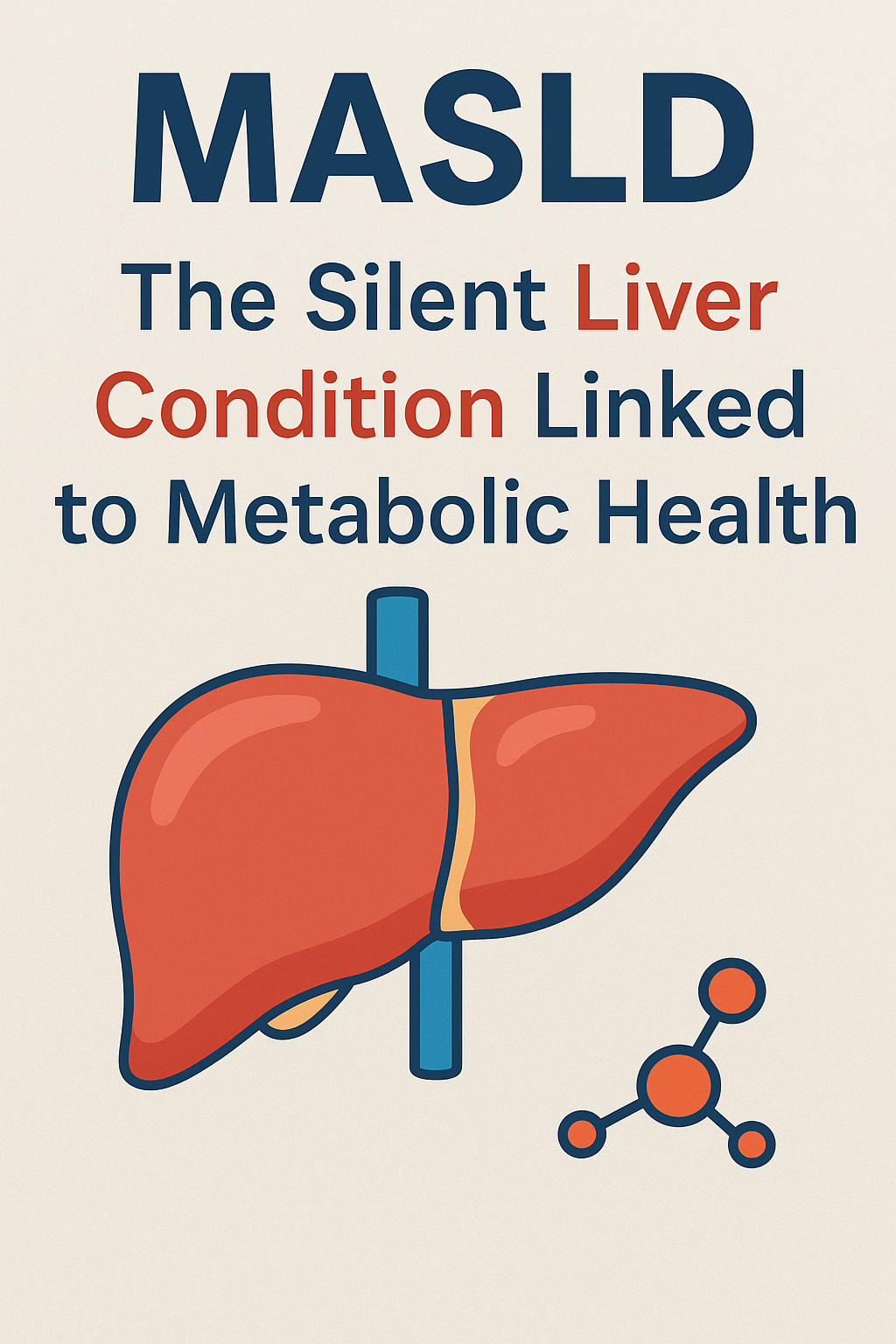Metabolic dysfunction-associated steatotic liver disease (MASLD) is now one of the most common liver conditions globally, affecting nearly 1 in 4 adults. Yet most people don’t know they have it because it can quietly progress without symptoms.
Previously known as NAFLD (Non-Alcoholic Fatty Liver Disease), this condition has undergone a major change in terminology and diagnostic approach. The new name—MASLD—reflects the core role of metabolic dysfunction in driving the disease.
Let’s break down what MASLD really is, why the terminology changed, what metabolic markers matter most, and how you can protect your liver. 🍏🧘♀️
⭐ Why NAFLD Is Now Called MASLD
In 2023, major liver societies—including AASLD and EASL—agreed to replace the term NAFLD with MASLD to:
✔ Remove the outdated focus on “non-alcoholic,”
✔ Highlight the central role of metabolic dysfunction,
✔ Reduce stigma,
✔ Improve diagnostic clarity.
The umbrella term Steatotic Liver Disease (SLD) now includes:
-
MASLD → Liver fat + metabolic dysfunction
-
MetALD → Liver fat + moderate alcohol intake
-
ALD → Alcohol-related liver disease
-
Other SLDs (medication-related, genetic, etc.)
This shift helps clinicians diagnose and treat patients more precisely. 🩺📊
⭐ What Exactly Is MASLD?
MASLD is defined as fat accumulation in the liver (≥5%) plus at least one cardiometabolic risk factor such as:
-
Overweight or obesity
-
Type 2 diabetes
-
High triglycerides
-
High blood pressure
-
Insulin resistance
-
Elevated fasting glucose
When inflammation or liver cell damage appears, MASLD can progress to MASH (Metabolic dysfunction–associated steatohepatitis), fibrosis, cirrhosis, or even liver cancer.
⭐ Why MASLD Matters: Health Risks You Shouldn’t Ignore ⚠️
Even in early stages, MASLD increases your risk of:
🔥 Type 2 diabetes
🔥 Cardiovascular disease (the #1 cause of death in MASLD patients)
🔥 High blood pressure
🔥 Chronic kidney disease
🔥 Liver cirrhosis
🔥 Liver cancer
The liver is the central metabolic organ, so dysfunction here signals widespread metabolic imbalance. 🧬
⭐ Key Metabolic Markers to Track for MASLD 🧪
Monitoring metabolic markers gives a complete picture of your liver and metabolic health. These are the ones with the strongest evidence:
1️⃣ Liver Enzymes
-
ALT, AST → May be normal even in severe MASLD
-
GGT → Often elevated earlier
-
ALP → Indirect marker
2️⃣ Insulin Resistance Markers
-
HOMA-IR → One of the strongest predictors of MASLD
-
Fasting insulin
3️⃣ Lipid Panel
-
High triglycerides
-
Low HDL
-
High LDL (especially small dense LDL)
4️⃣ Glucose Control
-
Fasting glucose
-
HbA1c
5️⃣ Inflammatory Markers
-
hs-CRP
-
TNF-α, IL-6 (research settings)
6️⃣ Liver Fibrosis Markers
-
FIB-4 score
-
NAFLD/MASLD Fibrosis Score
-
Transient elastography (FibroScan)
7️⃣ Emerging Markers
-
Cystatin C (renal & metabolic health)
-
Homocysteine
-
Ferritin (marker of inflammation/iron overload)
Tracking these regularly helps detect MASLD early and monitor improvement. 📈✨
⭐How MASLD Is Diagnosed 🖥️
Diagnosis typically involves:
-
Ultrasound / FibroScan to detect fat
-
Blood tests for metabolic markers
-
Clinical risk factor evaluation
-
Exclusion of alcohol or viral causes
⭐ How to Manage & Reverse MASLD Naturally 🌿
Research shows MASLD is highly reversible, especially in early stages.
1. Weight loss (5–10%)
The most powerful intervention. Reduces liver fat, inflammation, and fibrosis.
2. Anti-inflammatory diet
-
High fiber
-
Antioxidants (berries, greens)
-
Omega-3s (flaxseed, walnuts)
-
Low refined carbs
-
Limit sugar (especially fructose)
3. Exercise 🏃♀️
-
150–300 min/week of moderate activity
-
Resistance or Strength training 2–3x/week
-
Even without weight loss, exercise reduces liver fat
4. Manage gut health
-
Reduce ultra-processed foods
5. Treat metabolic conditions
Correcting insulin resistance and dyslipidemia also improves liver health.
⭐ FAQ Section ❓
1. Can MASLD occur in people who are not overweight?
Yes! Up to 20% of lean individuals have MASLD due to insulin resistance, genetics, or visceral fat.
2. Can liver enzymes be normal in MASLD?
Absolutely. Many patients with advanced fibrosis have normal ALT/AST.
3. Is MASLD reversible?
Yes—especially in early stages. Even 7% weight loss can reverse inflammation.
4. Is alcohol allowed in MASLD?
Light alcohol is discouraged as it may accelerate fibrosis.
5. Should I take supplements for MASLD?
Evidence-based supplements include:
-
Vitamin E (in non-diabetics)
-
Omega-3
-
Vitamin D (if low)
Always consult your doctor.
6. Does alcohol cause MASLD?
MASLD is based on metabolic dysfunction.
If alcohol is involved, the disease is categorized differently (MetALD).
Conclusion 💡
MASLD represents a major shift in how we think about fatty liver disease — not as a simple liver condition but as a reflection of deeper metabolic dysfunction.
Understanding metabolic markers, improving lifestyle habits, and early screening are the most powerful ways to protect your liver and long-term health.
⭐ Reference List
American Association for the Study of Liver Diseases. (2023). New MASLD nomenclature and definition update. https://pubmed.ncbi.nlm.nih.gov/37597413/
Francque, S., et al. (2021). Non-alcoholic fatty liver disease: a patient guideline. Journal of Hepatology, 75(4), 1097–1111. https://pubmed.ncbi.nlm.nih.gov/33798592/
Eslam, M., et al. (2020). MAFLD vs NAFLD: New nomenclature rationale. Gastroenterology, 158(7), 1999–2014. https://pubmed.ncbi.nlm.nih.gov/32278004/
Younossi, Z., et al. (2018). Global epidemiology of NAFLD. Hepatology, 64(1), 73–84. https://pubmed.ncbi.nlm.nih.gov/26707365/
Chalasani, N., et al. (2018). Diagnosis and management of NAFLD. Hepatology, 67(1), 328–357. https://pubmed.ncbi.nlm.nih.gov/28714183/
Targher, G., et al. (2016). Cardiovascular risk in NAFLD. Nature Reviews Cardiology, 13(4), 230–241. https://pubmed.ncbi.nlm.nih.gov/26743091/
Byrne, C. D., & Targher, G. (2015). NAFLD and risk of diabetes. Diabetes Care, 38(11), 1876–1885. https://pubmed.ncbi.nlm.nih.gov/26519337/
Sanyal, A. J. (2019). NASH treatment strategies. Hepatology Communications, 3(9), 1212–1225. https://pubmed.ncbi.nlm.nih.gov/31555405/
Loomba, R., et al. (2021). MASLD progression predictors. Journal of Hepatology, 74(2), 233–244. https://pubmed.ncbi.nlm.nih.gov/32950516/
Aron-Wisnewsky, J., et al. (2020). The gut–liver axis in NAFLD. Gastroenterology, 158(8), 2447–2463. https://pubmed.ncbi.nlm.nih.gov/32165248/

Akanksha Sharma
Dr. Akanksha Sharma, Head Writer and creator of AtoZ of Pregnancy, is dedicated to empowering women, parents, and families through 360-degree knowledge. She and her team provide evidence-based advice to guide families through pregnancy, parenting and beyond.






Leave a Reply